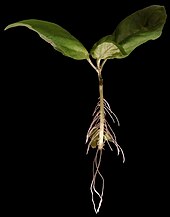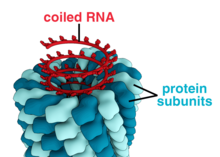An organism is defined in a medical dictionary as any living thing that functions as an individual.[1] Such a definition raises more problems than it solves, not least because the concept of an individual is also difficult. Many criteria, few of them widely accepted, have been proposed to define what is an organism. Among the commonest is that an organism has autonomous reproduction, growth, and metabolism. This would exclude viruses, despite that fact that they evolve like organisms. Other problematic cases include colonial organisms; a colony of eusocial insects is organised adaptively, and has germ-soma specialisation, with some insects reproducing, others not, like cells in an animal's body. The body of a siphonophore, a jelly-like marine animal, is composed of organism-like zooids, but the whole structure looks and functions much like an animal such as a jellyfish, the parts collaborating to provide the functions of the colonial organism.
The evolutionary biologists David Queller and Joan Strassmann state that "organismality", the qualities or attributes that define an entity as an organism, has evolved socially as groups of simpler units (from cells upwards) came to cooperate without conflicts. They propose that cooperation should be used as the "defining trait" of an organism. This would treat many types of collaboration, including the fungus/alga partnership of different species in a lichen, or the permanent sexual partnership of an anglerfish, as an organism.
Etymology
The term "organism" (from the Ancient Greek ὀργανισμός, derived from órganon, meaning instrument, implement, tool, organ of sense or apprehension)[2][3] first appeared in the English language in the 1660s with the now-obsolete meaning of an organic structure or organization.[3] It is related to the verb "organize".[3] In his 1790 Critique of Judgment, Immanuel Kant defined an organism as "both an organized and a self-organizing being".[4][5]
Whether criteria exist, or are needed

Among the criteria that have been proposed for being an organism are:
- autonomous reproduction, growth, and metabolism[7]
- noncompartmentability – structure cannot be divided without losing functionality.[6] Richard Dawkins stated this as "the quality of being sufficiently heterogeneous in form to be rendered non-functional if cut in half".[8] However, many organisms can be cut into pieces which then grow into whole organisms.[8]
- individuality – the entity has simultaneous holding of genetic uniqueness, genetic homogeneity and autonomy[9]
- an immune response, separating self from foreign[10]
- "anti-entropy", the ability to maintain order, a concept first proposed by Erwin Schrödinger;[11] or in another form, that Claude Shannon's information theory can be used to identify organisms as capable of self-maintaining their information content[12]
Other scientists think that the concept of the organism is inadequate in biology;[13] that the concept of individuality is problematic;[14] and from a philosophical point of view, question whether such a definition is necessary.[15][16][8]
Problematic cases include colonial organisms: for instance, a colony of eusocial insects fulfills criteria such as adaptive organisation and germ-soma specialisation.[17] If so, the same argument, or a criterion of high co-operation and low conflict, would include some mutualistic (e.g. lichens) and sexual partnerships (e.g. anglerfish) as organisms.[18] If group selection occurs, then a group could be viewed as a superorganism, optimized by group adaptation.[19]
Another view is that attributes like autonomy, genetic homogeneity and genetic uniqueness should be examined separately rather than demanding that an organism should have all of them; if so, there are multiple dimensions to biological individuality, resulting in several types of organism.[20]
Organisms at differing levels of biological organisation

A unicellular organism is a microorganism such as a protist, bacterium, or archaean, composed of a single cell, which may contain functional structures called organelles.[22]
A multicellular organism such as an animal, plant, fungus, or alga is composed of many cells, often specialised.[22]
A colonial organism such as a siphonophore is a being which functions as an individual but is composed of communicating individuals.[8]
A superorganism is a colony, such as of ants, consisting of many individuals working together as a single functional or social unit.[23][17]
A mutualism is a partnership of two or more species which each provide some of the needs of the other. A lichen consists of fungi and algae or cyanobacteria, with a bacterial microbiome; together, they are able to flourish as a kind of organism, the components having different functions, in habitats such as dry rocks where neither could grow alone.[18][21]
The evolutionary biologists David Queller and Joan Strassmann state that "organismality" has evolved socially, as groups of simpler units (from cells upwards) came to cooperate without conflicts. They propose that cooperation should be used as the "defining trait" of an organism.[18]
| Level | Example | Composition | Metabolism, growth, reproduction | Co-operation |
|---|---|---|---|---|
| Virus | Tobacco mosaic virus | Nucleic acid, protein | No | No metabolism, so not living, not an organism, say many biologists;[7] but they evolve, their genes collaborating to manipulate the host[18] |
| Unicellular organism | Paramecium | One cell, with organelles e.g. cilia for specific functions | Yes | Inter-cellular (inter-organismal) signalling[22] |
| Swarming protistan | Dictyostelium (cellular slime mould) | Unicellular amoebae | Yes | Free-living unicellular amoebae for most of lifetime; swarm and aggregate to a multicellular slug, cells specialising to form a dead stalk and a fruiting body[18] |
| Multicellular organism | Mushroom-forming fungus | Cells, grouped into organs for specific functions (e.g. reproduction) | Yes | Cell specialisation, communication[22] |
| Permanent sexual partnership | Anglerfish | Male and female permanently fastened together | Yes | Male provides male gametes; female provides all other functions[18] |
| Mutualism | Lichen | Organisms of different species | Yes | Fungus provides structure, absorbs water and minerals; alga photosynthesises[18] |
| Joined colony | Siphonophore | Zooids joined together | Yes | Organism specialisation; inter-organism signalling[8] |
| Superorganism | Ant colony | Individuals living together | Yes | Organism specialisation (many ants do not reproduce); inter-organism signalling[23] |
Samuel Díaz‐Muñoz and colleagues (2016) accept Queller and Strassmann's view that organismality can be measured wholly by degrees of cooperation and of conflict. They state that this situates organisms in evolutionary time, so that organismality is context dependent. They suggest that highly integrated life forms, which are not context dependent, may evolve through context-dependent stages towards complete unification.[24]
Boundary cases: viruses

Viruses are not typically considered to be organisms, because they are incapable of autonomous reproduction, growth, metabolism, or homeostasis. Although viruses have a few enzymes and molecules like those in living organisms, they have no metabolism of their own; they cannot synthesize the organic compounds from which they are formed. In this sense, they are similar to inanimate matter.[7] Viruses have their own genes, and they evolve. Thus, an argument that viruses should be classed as living organisms is their ability to undergo evolution and replicate through self-assembly. However, some scientists argue that viruses neither evolve nor self-reproduce. Instead, viruses are evolved by their host cells, meaning that there was co-evolution of viruses and host cells. If host cells did not exist, viral evolution would be impossible. As for reproduction, viruses rely on hosts' machinery to replicate. The discovery of viruses with genes coding for energy metabolism and protein synthesis fuelled the debate about whether viruses are living organisms, but the genes have a cellular origin. Most likely, they were acquired through horizontal gene transfer from viral hosts.[7]
Radosław Piast compares viruses to cellular organisms. He comments that whereas in 1983, Claudiu Bandea claimed that a virus "shows the major physiological properties of other organisms: metabolism, growth, and reproduction. Therefore, life is an effective presence",[12][25] viruses do not possess these capabilities but rely exclusively on their hosts for all such cellular processes.[12]
| Capability | Cellular organism | Virus |
|---|---|---|
| Metabolism | Yes | No, rely entirely on host cell |
| Growth | Yes | No, just self-assembly |
| Reproduction | Yes | No, rely entirely on host cell |
| Store genetic information about themselves | DNA | DNA or RNA |
| Able to evolve | Yes: mutation, recombination, natural selection | Yes: high mutation rate, natural selection |
Boundary cases: organism-like colonies

The philosopher Jack A. Wilson examines some boundary cases to demonstrate that the concept of organism is not sharply defined.[8] In his view, sponges, lichens, siphonophores, slime moulds, and eusocial colonies such as of ants or naked molerats, all lie in the boundary zone between being definite colonies and definite organisms (or superorganisms).[8]
| Function | Colonial siphonophore | Jellyfish |
|---|---|---|
| Buoyancy | Top of colony is gas-filled | Jelly |
| Propulsion | Nectophores co-ordinate to pump water | Body pulsates to pump water |
| Feeding | Palpons and gastrozooids ingest prey, feed other zooids | Tentacles trap prey, pass it to mouth |
| Functional structure | Single functional individual | Single functional individual |
| Composition | Many zooids, possibly individuals | Many cells |
Boundary cases: synthetic organisms

Scientists and bio-engineers are experimenting with different types of synthetic organism, from chimaeras composed of cells from two or more species, cyborgs including electromechanical limbs, hybrots containing both electronic and biological elements, and other combinations of systems that have variously evolved and been designed.[26]
An evolved organism takes its form by the partially understood mechanisms of evolutionary developmental biology, in which the genome directs an elaborated series of interactions to produce successively more elaborate structures. The existence of chimaeras and hybrids demonstrates that these mechanisms are "intelligently" robust in the face of radically altered circumstances at all levels from molecular to organismal.[26]
Synthetic organisms already take diverse forms, and their diversity will increase. What they all have in common is a teleonomic or goal-seeking behaviour that enables them to correct errors of many kinds so as to achieve whatever result they are designed for. Such behaviour is reminiscent of intelligent action by organisms; intelligence is seen as an embodied form of cognition.[26]
References
External links
- "The Tree of Life". Tree of Life Web Project.
- "Indexing the world's known species". Species 2000. aims to enumerate all known species.